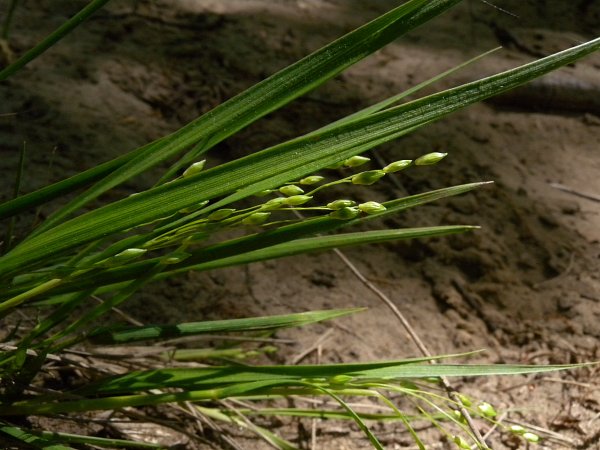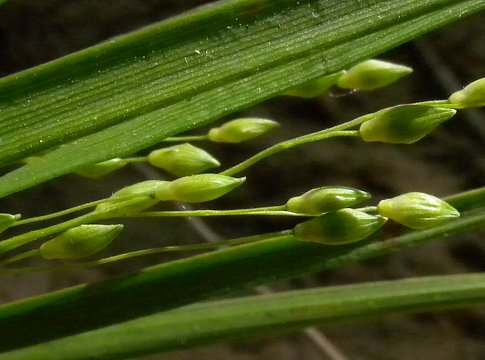
Each vernal culm terminates in an exerted panicle of spikelets about 1½–3" long and less than 1" across. Along the central stalk of this panicle, there are a few lateral branches that are erect to stiffly ascending. These lateral branches subdivide into short branchlets that terminate into individual spikelets. The central stalk and branches of the panicle are narrow, wiry, and glabrous. The spikelets are 3-4 mm. long (typically about 3.5 mm.) and 1.5 mm. across (or a little more). Overall, they are ellipsoid in shape, longitudinally veined, and usually glabrous (although sometimes they are sparsely pubescent). The tips of these spikelets have a beak-like shape. Immature spikelets are green, while mature spikelets become light brown. Each spikelet has a short glume, long glume, lemma, and floret. The short glume is about one-third of the length of the spikelet, while the long glume and lemma are the same length of the spikelet and comprise its two sides. Each floret consists of a pair of feathery red stigmata, the anthers, and an ovary. These florets bloom during the late spring for 1-2 weeks; they
 are
cross-pollinated by the wind. In its autumnal form, this grass branches
at the base, forming a tuft of short leafy culms. Some of the sheaths
of these culms contain small panicles of spikelets that are at least
partially hidden. The florets of these autumnal spikelets are
self-fertile. The grains of this grass are about 2.0 mm. long, 1.5
mm. across, broadly ellipsoid in shape, and slightly flattened. The
root system consists of a crown of fibrous roots.
are
cross-pollinated by the wind. In its autumnal form, this grass branches
at the base, forming a tuft of short leafy culms. Some of the sheaths
of these culms contain small panicles of spikelets that are at least
partially hidden. The florets of these autumnal spikelets are
self-fertile. The grains of this grass are about 2.0 mm. long, 1.5
mm. across, broadly ellipsoid in shape, and slightly flattened. The
root system consists of a crown of fibrous roots.Cultivation: The preference is full or partial sun, dry conditions, and sterile soil containing sand or rocky material.
Range & Habitat: The native Starved Panic Grass (Dichanthelium depauperatum) is occasional in most areas of Illinois, although in the east-central section of the state it is largely absent. Habitats include upland rocky woodlands, upland sandy woodlands, upland savannas and upland sandy savannas, dry prairies and sand prairies, rocky glades, wooded sand dunes along Lake Michigan, abandoned sandy fields, and sterile waste areas. Occasional wildfires are probably beneficial in maintaining appropriate habitat for this grass, especially when the overhead canopy of woody vegetation is reduced. Starved Panic Grass can be found in both high quality natural areas and disturbed areas that are sandy, rocky, or gravelly.
Faunal Associations: Various insects feed on the foliage, plant juices, and other parts of panic grasses (Dichanthelium spp., Panicum spp.). This includes the leaf beetle Chalepus bicolor, the stilt bug Jalysus spinosus, the stink bug Mormidea lugens, the aphid Prociphilus erigeronensis, various leafhoppers, the larvae of various moths, and the larvae of various skippers. The Insect Table lists some of these insects. As an upland grass, the seeds of Starved Panic Grass (Dichanthelium depauperatum) are eaten by upland gamebirds and granivorous songbirds, including the Ring-Necked Pheasant, Bobwhite Quail, Wild Turkey, Mourning Dove, Dickcissel, Horned Lark, Field Sparrow, Savannah Sparrow, and White-Crowned Sparrow (see the Bird Table for a more complete listing of these species). Among mammals, the House Mouse and Deer Mouse also eat the seeds of panic grasses, while the White-Tailed Deer and Cottontail Rabbit browse on the foliage occasionally. In addition, the young foliage is palatable to such domesticated animals as cattle, horses, and sheep.
Photographic Location: A wooded sand dune along Lake Michigan at the Indiana Dunes State Park in NW Indiana.

Comments: There are several dozen species in the Dichanthelium genus that are native to the state of Illinois. All of these species were assigned to the Panicum genus not so very long ago. Starved Panic Grass (Dichanthelium depauperatum) can be distinguished from most of these species by its narrow leaf blades (only 2-4 mm. across). Among those few species remaining with leaf blades less than 5 mm. across, Starved Panic Grass can be distinguished by the longer length of its spikelets (typically 3.5 mm. long) and their beak-like tips. Spikelets of similar species in this genus have shorter spikelets with more rounded tips. Starved Panic Grass has a somewhat unusual appearance because of its erect to ascending leaf blades (relative to the orientation of its culms); both its culms and leaf blades appear stiff and straight. As a result, robust tufts of the vernal form of this grass in sunny areas can resemble small yucca plants.